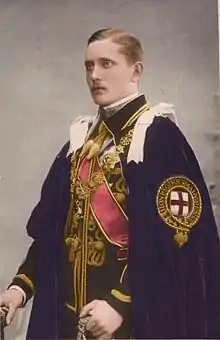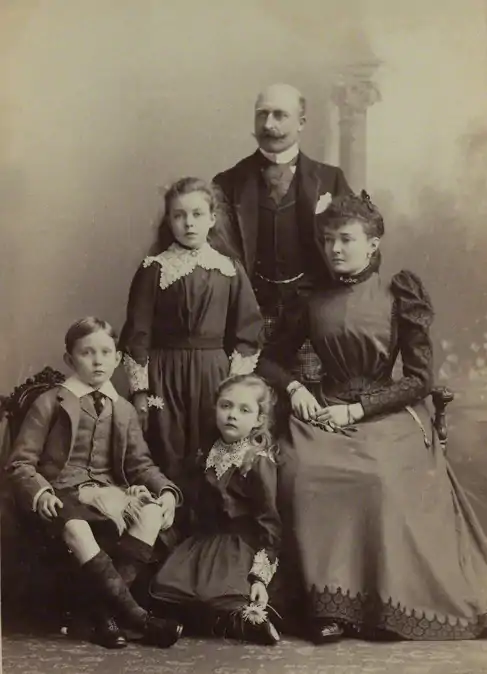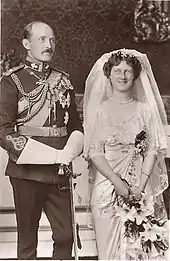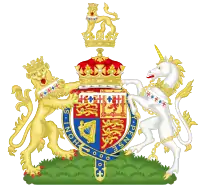Prince Arthur of Connaught
Prince Arthur of Connaught KG KT GCMG GCVO GCStJ CB PC (Arthur Frederick Patrick Albert; 13 January 1883 – 12 September 1938) was a British military officer and a grandson of Queen Victoria. He served as Governor-General of the Union of South Africa from 20 November 1920 to 21 January 1924.
| Prince Arthur | |||||
|---|---|---|---|---|---|
 Prince Arthur in the robes of the Order of the Garter | |||||
| 3rd Governor-General of South Africa | |||||
| In office | 20 November 1920 – 21 January 1924 | ||||
| Predecessor | The Viscount Buxton | ||||
| Successor | The Earl of Athlone | ||||
| Prime Minister | Jan Christiaan Smuts | ||||
| Born | 13 January 1883 Windsor Castle, Berkshire | ||||
| Died | 12 September 1938 (aged 55) London, England | ||||
| Burial | 22 September 1938 | ||||
| Spouse | |||||
| Issue | Alastair, 2nd Duke of Connaught and Strathearn | ||||
| |||||
| House | Windsor (from 1917) Saxe-Coburg and Gotha (until 1917) | ||||
| Father | Prince Arthur, Duke of Connaught and Strathearn | ||||
| Mother | Princess Louise Margaret of Prussia | ||||
| Military career | |||||
| Allegiance | |||||
| Service/ | |||||
| Years of service | 1901–1922 | ||||
| Rank | Colonel | ||||
| Unit | Royal Scots Greys | ||||
Early life

Prince Arthur was born on 13 January 1883 at Windsor Castle. His father was Prince Arthur, Duke of Connaught and Strathearn, third son of Queen Victoria and Prince Albert of Saxe-Coburg and Gotha. His mother was the former Princess Louise Margaret of Prussia.
Arthur was baptised in the Private Chapel of Windsor Castle on 16 February 1883, and his godparents were Queen Victoria (his paternal grandmother), Princess Augusta of Saxe-Weimar-Eisenach (his great-great aunt, for whom his paternal aunt Princess Beatrice stood proxy), Prince Friedrich Leopold of Prussia (his maternal uncle, who was represented by the German Ambassador Count Münster), Princess Henry of the Netherlands (his maternal aunt, who was represented by Countess Münster), Prince George, Duke of Cambridge (the Queen's cousin), and the Duke of Edinburgh (his paternal uncle, whose brother the Prince of Wales represented him).[1]
Arthur was the first British royal prince to be educated at Eton College. He was known to his family as "young Arthur" to distinguish him from his father.
Military career
Prince Arthur was educated at Eton College, but left there early to join the Royal Military College, Sandhurst at the age of sixteen years and two months.[2] From there he was commissioned into the 7th (Queen's Own) Hussars as a second lieutenant in May 1901. He saw his first active posting the following year. After the end of the Second Boer War in June 1902, most of the British troops left South Africa, but the 7th Hussars were posted there to keep the peace. Prince Arthur and 230 men of his regiment left Southampton in the SS Ortona in October 1902,[3] and arrived at Cape Town later the same month. He spent several months stationed at Krugersdorp. In 1907, he was promoted to the rank of captain in the 2nd Dragoons (Royal Scots Greys). He became the honorary Colonel-in-Chief of this regiment in 1920.
During the First World War, Prince Arthur served as aide-de-camp to Generals Sir John French and Sir Douglas Haig, the successive commanders of the British Expeditionary Force in France and Belgium. He was promoted to lieutenant colonel in 1919 and became a colonel in the reserves in 1922. In October 1922, Prince Arthur was promoted to the honorary rank of major general and became an aide-de-camp to his first cousin, King George V.
Since the king's children were too young to undertake public duties until after the First World War, Prince Arthur carried out a variety of ceremonial duties at home and overseas.
Marriage

On 15 October 1913, Prince Arthur married his cousin Princess Alexandra, 2nd Duchess of Fife (17 May 1891 – 26 February 1959) at the Chapel Royal, St. James's Palace, London.[4]
The couple were attended by five bridesmaids: The Princess Mary, Princess Maud of Fife, Princesses Mary, Helena, and May of Teck.[5]
Princess Alexandra was the eldest daughter and heir of the 1st Duke of Fife and the Princess Royal, the eldest daughter of King Edward VII. As such, the couple were first cousins once removed. They had a son, Alastair.
Later life

After the accession of his cousin, King George V, Prince Arthur and his aging father were the most senior male members of the Royal Family over the age of 18 to reside in the United Kingdom. As such, he undertook a wide variety of royal duties on behalf of the King, and acted as a Counsellor of State during periods of the King's absence abroad.
In 1906, by order of the King, he vested the Meiji Emperor of Japan with the Order of the Garter, as a consequence of the Anglo-Japanese Alliance. In 1918, he was a guest aboard the Japanese battlecruiser Kirishima when she voyaged from Japan to Canada.[6] He visited Tokyo and then Nagoya and was welcomed at Tsuruma Park and the Buntenkaku, and then traveled on to Kyoto.[7] In 1920, Prince Arthur succeeded Viscount Buxton as governor-general and commander-in-chief in South Africa. The Earl of Athlone succeeded him in these posts in 1924. Upon returning to Britain, Prince Arthur became involved in a number of charitable organizations, including serving as chairman of the board of directors of Middlesex Hospital. Like his father, the Duke of Connaught, he was active in the Freemasons, becoming Provincial Grand Master for Berkshire in 1924.
Prince Arthur of Connaught died of stomach cancer at age 55 on 12 September 1938. He is buried in the Royal Burial Ground, Frogmore. One of his last public appearances was at the coronation of King George VI and Queen Elizabeth in May 1937. His father, the Duke of Connaught, survived him by four years. Prince Arthur's only son, who used the courtesy title Earl of MacDuff after 1917, succeeded his paternal grandfather as 2nd Duke of Connaught and Strathearn and Earl of Sussex in 1942.
Honours and arms
Military ranks
- 2Lt: 2nd Lieutenant, 7th (Queen's Own) Hussars (8 May 1901)
- Lt: Lieutenant, 7th (Queen's Own) Hussars (14 January 1903)
- Capt: Captain, 2nd Dragoons (The Royal Scots Greys) (27 April 1907)
- Bvt Maj: Brevet Major (14 October 1913)
- Maj: Major, 2nd Dragoons (The Royal Scots Greys) (19 August 1915)
- Bvt LtCol: Brevet Lieutenant-Colonel (3 June 1919)[8]
- Retired from active service (31 December 1919)[9]
- Hon Maj-Gen: Honorary Major-General (27 October 1920)[10]
- Col: Colonel, Reserve of Officers (1 March 1922[11] to 13 January 1938[12])
Honours
- Orders and appointments[13]
- KG: Royal Knight of the Garter (15 July 1902)[14]
- KT: Knight of the Thistle[12] (14 October 1913)
- PC: Privy Counsellor (11 June 1910)[15]
- CB: Companion of the Order of the Bath[12] (18 February 1915)
- Royal Victorian Chain[16] (15 May 1906) - for travelling to Japan and investing Emperor Meiji with the Order of the Garter
- GCMG: Knight Grand Cross of the Most Distinguished Order of St Michael and St George (3 September 1918)[17]
- GCVO: Knight Grand Cross of the Royal Victorian Order (24 May 1899)[18]
- Personal aide-de-camp to The King[12] (October 1922)
- GCStJ: Bailiff Grand Cross of St John (12 June 1926)[19]
- KJStJ: Knight of Justice of St John (25 July 1905)[20]
- Knight of St. Hubert (Bavaria)
- Grand Cordon of the Order of Leopold (Belgium)
- Knight of the Elephant (Denmark) (10 May 1914)[21]
- Grand Cordon of the Order of Muhammad Ali (Egypt)
- Grand Cross of the Legion d'Honneur (France)
- Grand Cross of the Order of the Redeemer (Greece)
- Knight of the Annunciation (Italy) (3 December 1904)[22]
- Grand Cordon of the Order of the Chrysanthemum (Japan) (14 February 1906)[23]
- Grand Cross of the Order of St. Olav (Norway)
- Knight of the Seraphim (Sweden) (14 June 1905)[24]
- Grand Cross of the Order of Carol I (Romania)
- Knight of St. Andrew (Russia)
- Knight 3rd Class with Swords of St. Vladimir (Russia)
- Grand Collar of the Order of Charles III (Spain) (18 May 1907)[25]
- Medals[13]
- 1914 Star (1917)
- British War Medal (1919)
- Victory Medal (1919)
- Queen Victoria Diamond Jubilee Medal (1897)
- King Edward VII Coronation Medal (1902)
- King George V Coronation Medal (1910)
- King George V Silver Jubilee Medal (1935)
- King George VI Coronation Medal (1937)
Honorary military appointments
Arms
As a male-line grandchild of a British sovereign, Prince Arthur was awarded, on his twenty-first birthday, the use of the royal arms, with an inescutcheon of the shield of Saxony, and differenced by a label argent, of five points, the outer pair and central point bearing crosses gules, and the inner pair fleur-de-lys azure. In 1917, the inescutcheon was dropped by royal warrant from George V.[28]
 |
.svg.png.webp) |
.svg.png.webp) |
|---|---|---|
Ancestry
| Ancestors of Prince Arthur of Connaught |
|---|
References
- "Yvonne's Royalty Home Page — Royal Christenings". Archived from the original on 6 August 2011. Retrieved 27 December 2010.
- Sir John George Smyth, Sandhurst: The History of the Royal Military Academy, Woolwich, the Royal Military College, Sandhurst, and the Royal Military Academy Sandhurst, 1741-1961 (London: Weidenfeld and Nicolson, 1961), p. 94
- "Departure of Prince Arthur of Connaught for South Africa". The Times (36893). London. 8 October 1902. p. 8.
- "Royal Wedding Group". National Portrait Gallery, London.
- "Royal Wedding Group". National Portrait Gallery.
- Hackett, Robert; Kingsepp, Sander (2001–2009). "IJN KIRISHIMA: Tabular Record of Movement". Combined Fleet. CombinedFleet.com. Retrieved 14 October 2009.
- https://www.iwm.org.uk/collections/item/object/1060022917
- "No. 31377". The London Gazette (Supplement). 3 June 1919. p. 7006.
- Quarterly Army List for quarter ending 31st December 1919 (London, 1920) Part I, p. 2002.
- "No. 32099". The London Gazette (Supplement). 26 October 1920. p. 10366.
- "No. 32626". The London Gazette (Supplement). 1 March 1922. p. 1797.
- "No. 34473". The London Gazette. 14 January 1938. p. 291. (Last reference to Prince Arthur's full titles)
- "The Royal Lineage." Burke's Peerage. London: Burke's Peerage Ltd, 1949, p. cclxxviii.
- "No. 27454". The London Gazette. 15 July 1902. p. 4509.
- "No. 28384". The London Gazette. 14 June 1910. p. 4164.
- "No. 27916". The London Gazette. 25 May 1906. p. 3655.
- "No. 30953". The London Gazette. 15 October 1918. p. 12120.
- "No. 27083". The London Gazette. 26 May 1899. p. 3335.
- "No. 33284". The London Gazette. 14 June 1927. p. 3836.
- "No. 27822". The London Gazette. 28 July 1905. p. 5219.
- Jørgen Pedersen (2009). Riddere af Elefantordenen, 1559–2009 (in Danish). Syddansk Universitetsforlag. p. 470. ISBN 978-87-7674-434-2.
- Italy. Ministero dell'interno (1920). Calendario generale del regno d'Italia. p. 57.
- 刑部芳則 (2017). 明治時代の勲章外交儀礼 (PDF) (in Japanese). 明治聖徳記念学会紀要. p. 150.
- Sveriges statskalender (in Swedish). 1925. p. 807. Retrieved 6 January 2018 – via runeberg.org.
- "Real y Distinguida Orden de Carlos III", Guóa Oficial de España (in Spanish), 1930, p. 221, retrieved 21 March 2019
- "No. 23523". The London Gazette (Supplement). 18 November 1921. p. 9220.
- "No. 34396". The London Gazette (Supplement). 11 May 1937. p. 3073.
- Heraldica – British Royalty Cadency
External links
| Wikimedia Commons has media related to Prince Arthur of Connaught. |
Prince Arthur of Connaught Cadet branch of the House of Wettin Born: 13 January 1883 Died: 12 September 1938 | ||
| Government offices | ||
|---|---|---|
| Preceded by The Viscount Buxton |
Governor-General of South Africa 1920–1924 |
Succeeded by The Earl of Athlone |
.svg.png.webp)
.svg.png.webp)